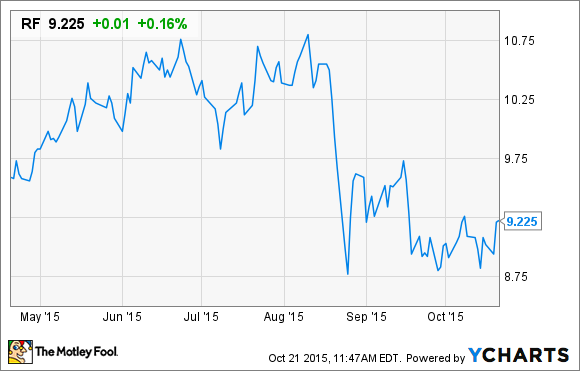Image source: Wikipedia user Billy Hathorn.
Regions Financial (RF 1.02%) reported its third-quarter earnings earlier this week, and the results were mixed. The bank slightly missed estimates for both earnings and revenue, and there were a few other negative aspects of the report as well. On the other hand, the loan portfolio is growing, deposits are up, and funding costs have never been lower. Here's a rundown of three of the top reasons to be bullish on Regions, as well as three potentially negative items you should be aware of.
Reasons to buy
There were definitely some positive aspects in Regions' third quarter.
For starters, the bank has done a good job of growing its loan portfolio throughout the past year. Growth was especially strong in business lending and vehicle loans, plus more people are opening checking accounts and credit cards with the bank. Even though the bank's net interest margin (NIM) dropped, the bank still posted an impressive quarterly increase in net interest income (NII) -- and the growth in lending was a main factor.

Data source: Company presentation.
Second, deposits have increased as well -- average deposits even grew during the third quarter, which was plagued with a volatile stock market and global economic uncertainty. Deposit growth is important as it is a source of low-cost funding for banks, especially with interest rates so low. In fact, Regions' deposit cost of just 11 bps (0.11%) is a historic low.
Finally, Regions is doing an excellent job of aggressively returning capital to shareholders and using the recently low share price to its advantage. During the quarter, Regions used $270 million of its $875 million approved repurchase plan, a sharp increase from the $172 million used in the second quarter. As explained by CFO David Turner, the bank chose to move a portion of its approved buybacks forward, and may continue to do so if the share price remains low, within the $875 million limit.
Reasons for caution
In addition to the good news mentioned above, it's important for shareholders to know in what areas Regions could use improvement in and where investors should watch closely in the coming quarters.
One area that the bank admittedly needs to work on is its expense management. Noninterest expenses were up substantially in the third quarter in contrast to much of the banking industry. For example, rival JPMorgan Chase (JPM 0.51%), which has been aggressively cutting expenses, managed to trim its noninterest expense by 3% year over year despite having higher legal costs. Regions, on the other hand, saw noninterest expense rise by more than 8% over the past year. Granted, some of this was due to seasonally high utility costs and increased investment in technology, but high expenses are still a potential profit killer.

Data source: Company presentation.
Expense cuts are essential to Regions achieving an efficiency ratio in the low 60s as the bank desires (current efficiency ratio is 65% and lower is better). It needs to get this number down significantly if it wants to be as profitable as some of the other banks in the industry, such as Wells Fargo and Citigroup (C 1.40%), which produced efficiency ratios of 56.7% and 55% (excluding legacy assets), respectively, in the third quarter.
Fortunately, management recognizes the need to rectify this, and made it clear several times during the conference call that they are taking steps to improve the bank's efficiency. For example, Regions recently implemented hiring restrictions and is reviewing all discretionary expenses going forward.
Another area of concern I have is the bank's capital ratios. While they still are well within the acceptable range, the trend has been downward while most other banks are going in the opposite direction. For example, Citigroup's Common Equity Tier 1 capital ratio improved from 10.6% to 11.6% over the past year, JPMorgan's has improved from 10.1% to 11.4%, and Bank of America's has risen from 9.5% to 10.8%. However, Regions' ratio has dropped from 11.2% to 10.7% in the same time period.

Data source: Company presentation.
The last thing I'm concerned about, which may or may not turn out to be a big deal, is Regions' lending exposure to the energy sector, which has been taking a beating since commodity prices have plummeted. Roughly $2.7 billion of Regions' $80.6 billion loan portfolio is directly linked to energy companies, and another $550 million is loaned to companies that are indirectly involved with energy.
The concern is that as energy companies are making less money, they could start to have a tough time paying their debts. However, Regions' management seems to be proactive here, staying in close contact with all of their clients and increasing reserves -- though, to be transparent, it's impossible for investors to gauge whether a bank like Regions is doing enough in this regard. During the conference call, management expressed its "cautious optimism" in regards to the energy lending, saying that their energy customers are taking appropriate actions and that any losses stemming from the energy portfolio should be manageable. Turner also added that "based on what we know today, losses could range in the $30 million to $50 million range," and that the bank's reserves would be sufficient to cover this.
Buy, sell, or hold
In my opinion, the most important takeaway from Regions' earnings report and conference call is that management is well aware of the areas that need to be monitored, as well as the things they need to improve. I'm curious to see what happens with capital ratios in the coming quarters, how aggressively the bank goes about trimming expenses, and whether the losses coming from the energy portfolio are actually within the range projected by the bank.
Having said that, I'm still bullish on Regions over the long run as I feel the bank has tremendous potential, but if I wasn't already a shareholder, I might wait to put money in.



